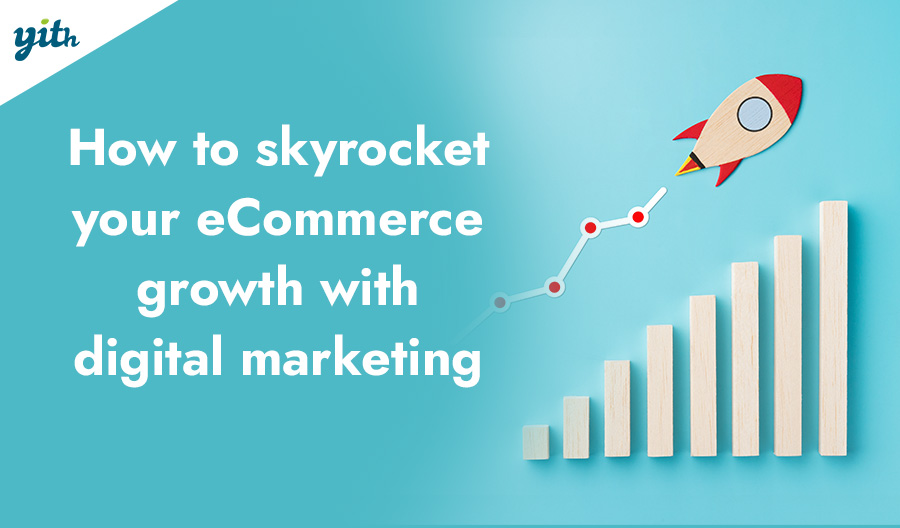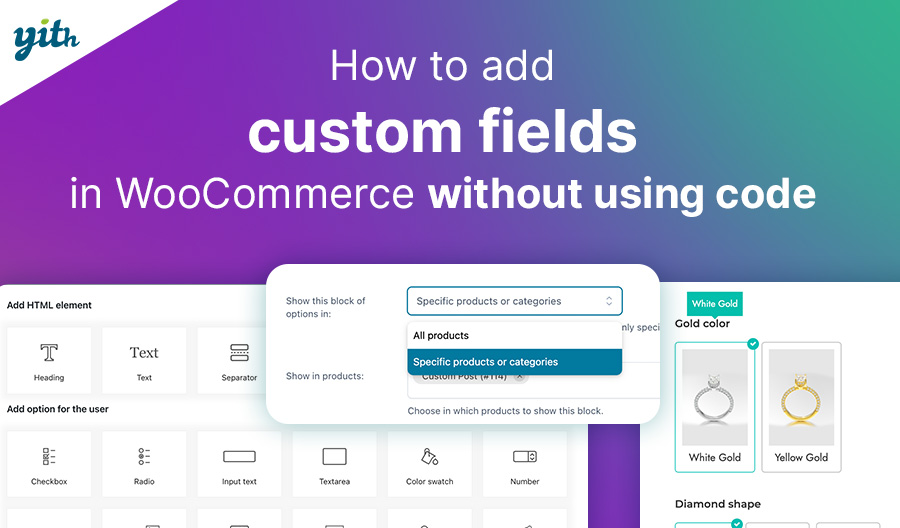Bundles are definitely something worth considering, just like any other sales method that has been proven effective worldwide for many years.
In this article, we’ll explore the concept of bundles, also referred to as product bundles. We’ll look into the advantages they bring to an online store and learn how to easily incorporate this feature into WordPress with a user-friendly plugin.
Let’s kick things off by explaining what bundles are.
Table of contents
- What are product bundles?
- Advantages of bundles for your WooCommerce store
- How to choose products for the bundle
- How to set the price for product bundles
- How to create product bundles with WooCommerce
- Best plugin for product bundles
- Difference between bundled and grouped products
- How to sell product bundles
- FAQ
- Conclusion

What are product bundles?
The word “bundle” typically describes a collection of items that are sold as a package. Many businesses, like Humble Bundle, use this approach to offer different products together.
In fact, this platform frequently provides its users with affordable bundles of digital resources, including video games, programming tools, and editing software.
Of course, it’s important to note that not all items can be bundled together (as we’ll explore later). However, the bundle option remains highly versatile and can be used in almost any type of store.
There are different forms of bundling as well. Sometimes, the items included in a bundle are exclusively available within that bundle. Other times, you can also buy these items individually (although it’s usually more cost-effective to purchase the bundle instead).
Now, why should you include bundles in your eCommerce store?

Advantages of bundles for your WooCommerce store
Thanks to product bundles you can boost sales of lesser-known items, increase AOV (Average Order Value), and easily employ marketing and sales strategies with just one click.
One clear example is connected to cross-selling. This technique typically means persuading a customer to buy more than one product. It’s easy to see how bundles make this process effortless.
Let’s look at a couple of real-life examples: we’ll explore the video games and the photography worlds.
In the first scenario, Mary is looking to buy a gift for her son, who has been asking for the newest gaming console available. So, when she visits your store, she will be specifically searching for this particular product.
Mary might not be aware that the console alone won’t be enough for her son to play. In reality, he will also require controllers, video games, and other accessories.
Now, in such a case, there can be multiple results:
- Mary realizes she needs these additional items and goes back to your online store to buy the rest.
- Mary realizes she needs these additional items and turns to another store to complete the set.
- Mary doesn’t buy anything else.
In two out of these three scenarios, you’ve missed out on a significant portion of the potential order’s worth. Keep in mind that the only sale you can truly rely on is the one that’s already been completed. Any deal set for the future carries a certain level of risk.
By offering a bundle that included all the necessary items for Mary’s son to enjoy the gaming console, you could have not only secured the purchase but also boosted its worth through cross-selling.
Let’s consider another scenario where Paul is interested in taking up photography as a new hobby. Being relatively new to this field, he makes the mistake of focusing solely on different camera models and overlooking essential accessories.
But Paul is also uncertain about what he needs and so he postpones the purchase. Once again the “Schrödinger sale” takes place, where the order is both unsuccessful and successful, until the customer finally makes a decision.
A smart seller, aware of this potential, has already put together a bundle with all the essential accessories for the camera, including a case, extra batteries, a memory card, an additional lens, and more.
Of course, customers have the option to search for each of these products. However, there are a few reasons why they may not fully complete their order. They might unintentionally overlook an accessory and end up purchasing it from a local store instead. They could also become tired during the purchase process, as they would need to individually search for each accessory.
By bundling items together, you can make the process quicker and more convenient for your customers. Keep in mind that people generally spend a short amount of time on eCommerce pages, usually ranging from 44 seconds to one minute and 22 seconds.
That’s why it’s important to be helpful and perhaps even offer a small discount to your customers — they won’t be able to resist the convenience of such an offer.
Not only can the bundle boost your average order value and sales, but it’s also a fantastic way to showcase your lesser-known products. By grouping them together with highly sought-after items, you can indirectly increase their sales too.

How to choose products for the bundle
Now that we’ve recognized the advantages of bundling, how do we go about selecting which products to bundle together? Well, it’s important to note that there are certain products that lend themselves well to bundling. In addition to the two examples given above, let’s look at some common types of bundles:
- Organic food and products – One of the leaders in the online sale of organic goods, effectively uses the bundle system. We are talking about HelloFresh which offers customers the freedom to select the specific products they want in their own bundles with an option to create a recurring plan based on their desired number of people and recipes per week (we will discuss how to do this later).
- Customers also bought – While this section may not offer bundle options, it can still provide valuable inspiration for creating your own. Take a look at online stores like Amazon and Reebok, which often suggest complementary items to go along with each product. Although creating a bundle eliminates the need for these suggestions, you can always check out what Amazon recommends among related products to make a good decision.
- By type – Let’s revisit Humble Bundle as an example to understand how they create their product bundles. While their offerings primarily focus on video games, they take a unique approach by categorizing the bundles based on game genres. This means you can explore adventure bundles, action bundles, role-playing bundles, and more. The same concept can be applied to create themed bundles for different products. For instance, if you specialize in children’s items, you could create a “Frog” bundle that includes various frog-related items like picture books, baby bottles, and clothing. By organizing your offerings in this way, you provide customers with tailored options that cater to specific interests or themes.
Lastly, a valuable resource available to you is connected to your own online shop: our top recommendation in this matter is to make the most of your eCommerce analytics.
Take a look at the sales data for each product and see which other items your customers have been buying on your website. If you notice any patterns or similarities, it might be worth considering creating a bundle with these products included.

How to set the price for product bundles
So now we understand the reasons behind creating bundles and which items to include in them. But it’s equally important to determine the appropriate price for this kind of product.
When it comes to bundles, just remember that the price should generally be lower than what you would pay if you bought each item separately.
Let’s take an example: if product A costs $10 and product B costs $15, the price of your bundle should be less than their combined cost (which is $25) to encourage your customers to make a purchase.
Actually, it’s quite handy to highlight the money you can save by using phrases like “Just $20 instead of $25!” or “A $25 value” or even “Save $5”.
Of course, the price of the promotion will rely on the approach you choose for your store and your profit margin. Just keep in mind that if you plan on including a less popular item in the bundle, you’ll need to offer a higher discount.
Some customers might also think “I don’t want this item, so I should buy the items separately.” In that case, it might come in handy to offer the option to customize the bundle and choose between two or more items before buying.
How to create product bundles with WooCommerce
Now that we understand the important elements of a product bundle, let’s see how to create one using WooCommerce. Despite having many useful features, this platform does not include a built-in bundle feature.
There are products that are grouped together, but they aren’t exactly identical (we’ll discuss the contrast between bundled and grouped products in more detail later on).
The good news is, you can easily add this missing feature to WooCommerce with a plugin. There are many options available online, but we’ve selected the top choice for this guide.
Best plugin for product bundles
The plugin we are going to use in this article is WooCommerce Product Bundles.
You can get the plugin for free or upgrade to the premium version, which has additional features like the support of simple and variable products. And it’s really easy to use!
After installing and activating the plugin, you can create a product as you normally would. On the product page, scroll down to “Product Data” and select “Product Bundle” from the available options:
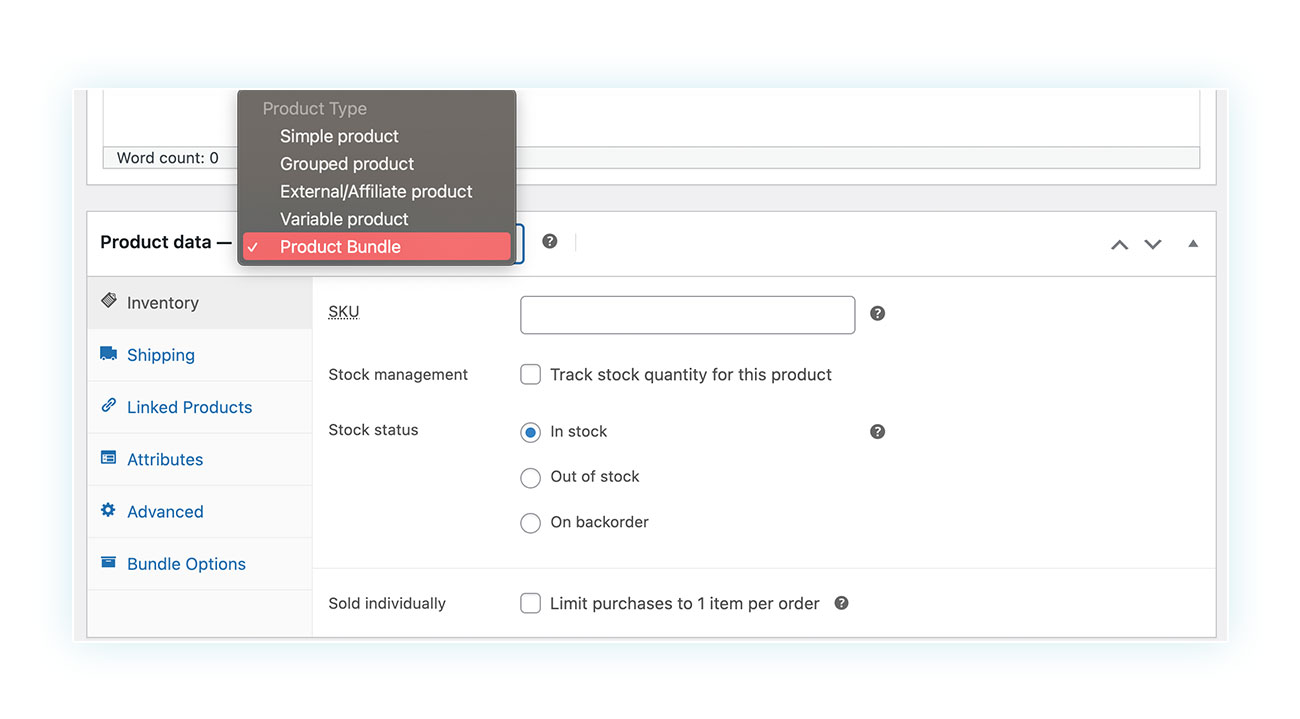
By selecting this product type, a new tab will be generated in this section called “Bundle Options.” Here, you can explore all the available choices that impact the bundle and include products that are already available in the store:
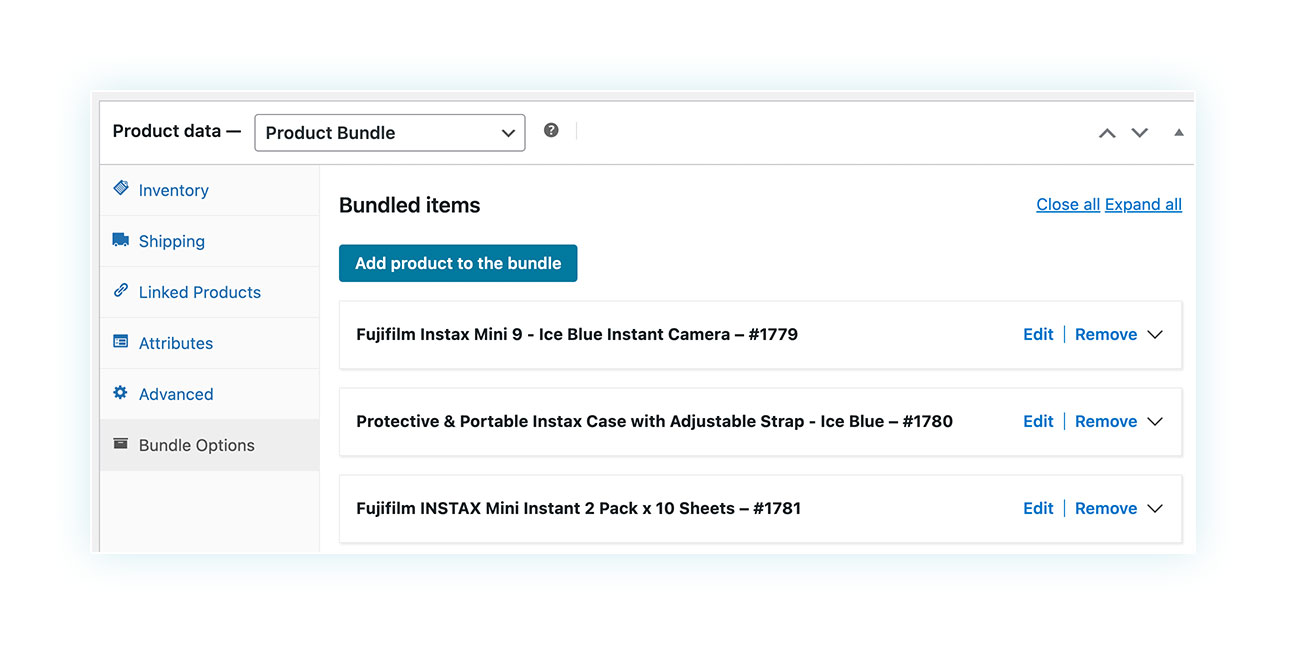
If you keep scrolling, you’ll come across several choices:
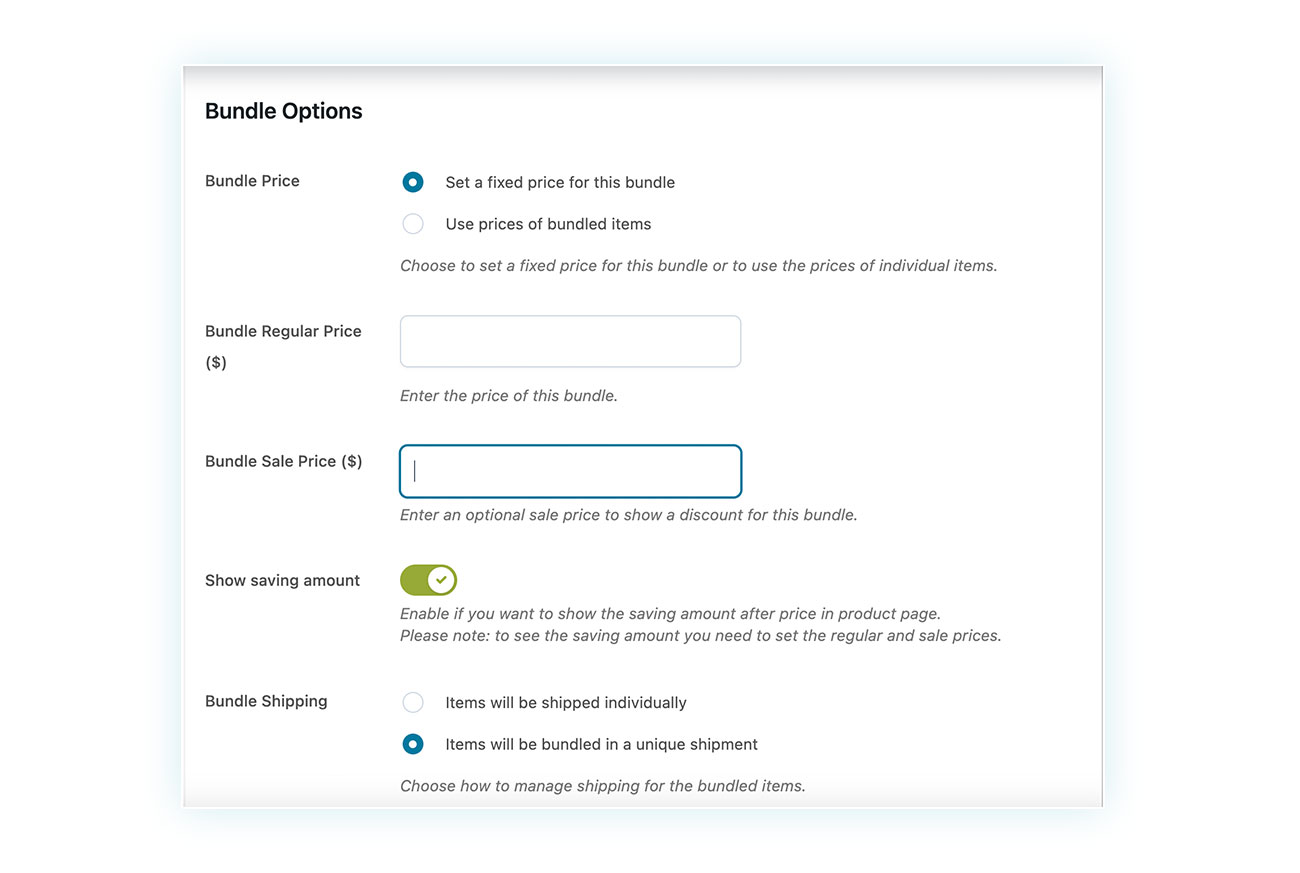
Among these, we find:
- Bundle price – You can manually set the bundle price in the related fields or add up the price of the products automatically.
- Show saving amount – You can show the actual savings to your customers on the product page.
- Bundle shipping – You can choose to ship all the products in the bundle together or ship them individually.
After setting up the bundle, it will look something like this:
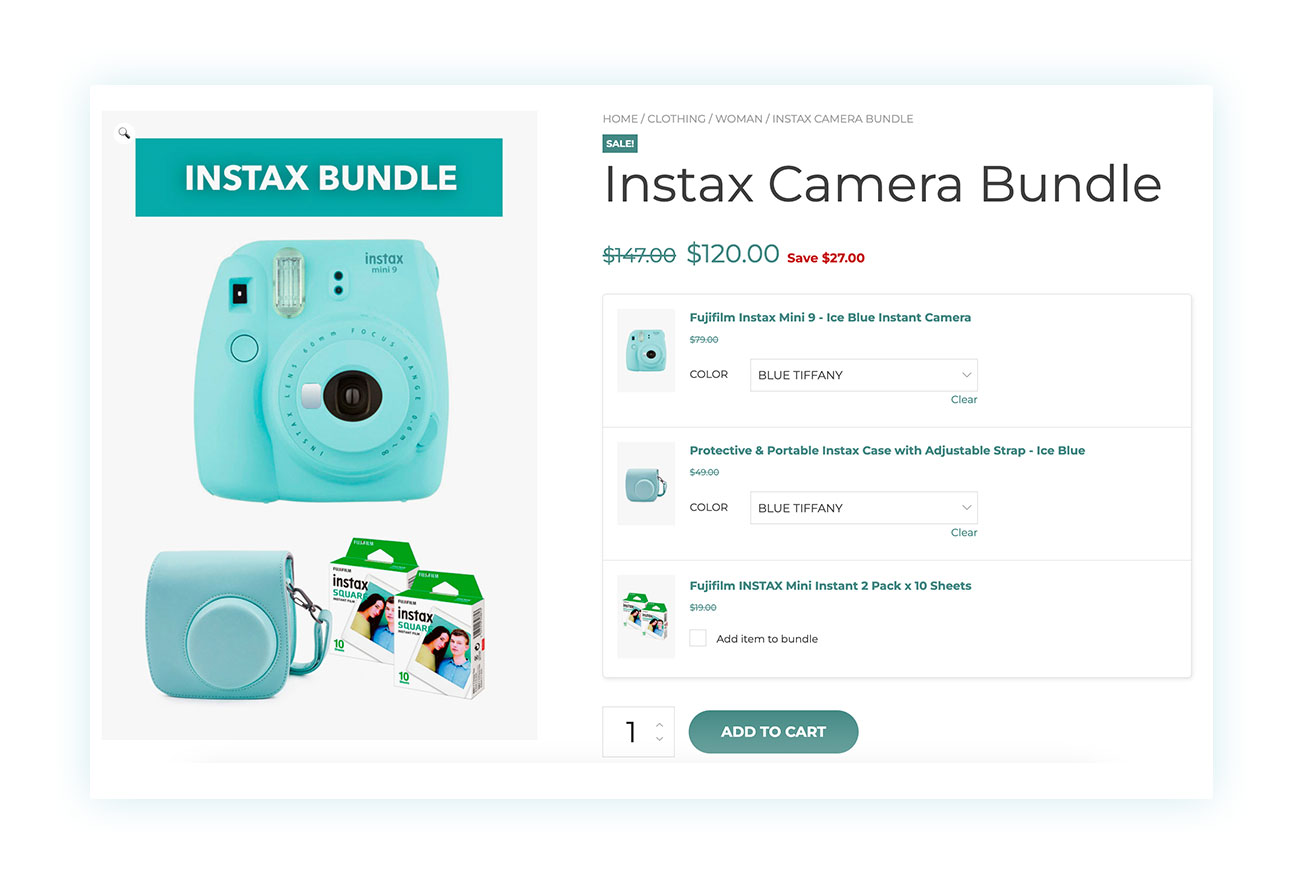
To set the price style visible to customers, simply visit YITH > Product Bundles and select your preferred option:
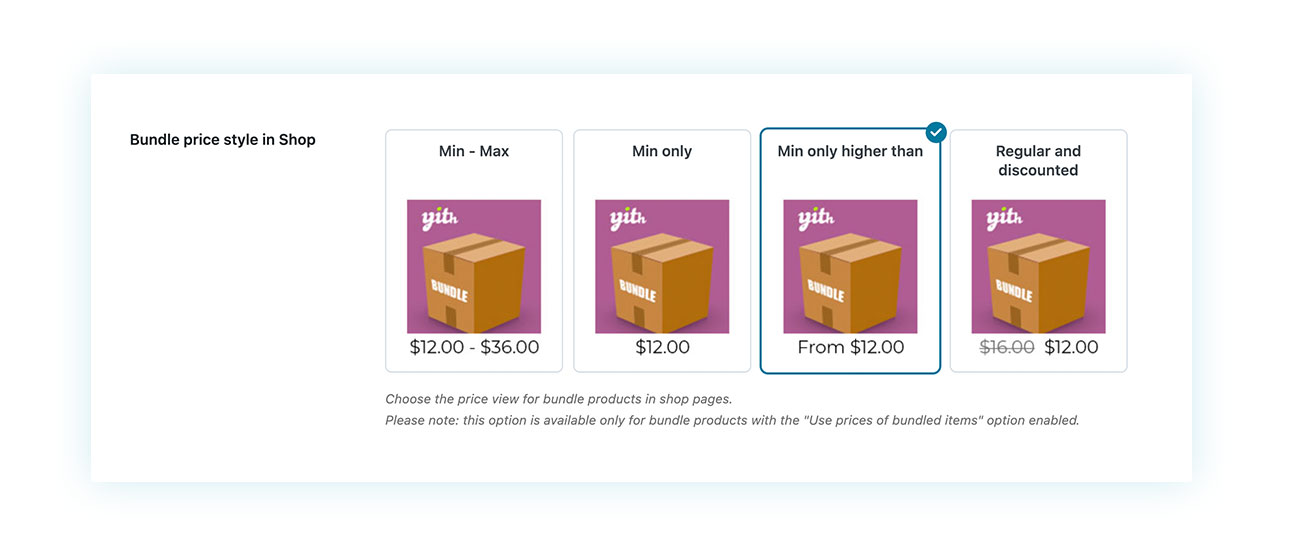
You can choose whether to:
- Show both the minimum and maximum value of the bundle
- Show only the minimum value
- Show only the minimum value but with the word “From…”
- Show the regular and the discounted price
Naturally, the choice depends entirely on your personal style and sales approach. Within this same section, you’ll find other options to configure the plugin according to your needs.
As you can see, creating product bundles in WooCommerce is easy and offers many advantages with minimal effort.
If you prefer watching a video to learn more about selling bundles with this plugin, you can refer to this YouTube tutorial:
Difference between bundled and grouped products
When it comes to bundles, it’s common to get confused because there are similar solutions available. Specifically, some sellers may not have a clear distinction between a “Grouped product” and a “Bundled product”.
The difference lies in the product itself: a bundle provides greater flexibility to customize the product selection, resulting in specific discounts and the use of marketing tactics. Additionally, bundles may contain unique items that are not available for individual purchase at the store.
When it comes to “grouped” products, all you’re doing is bringing together a bunch of products that have something in common. It’s just a way of organizing items based on a specific feature they share.
Using the camera scenario mentioned earlier, you could create a grouped product by adding all the Canon products. This way, customers can pick and choose which products they want to add to their cart, making their browsing experience much easier.
However, the grouped product has limitations in terms of function. It does not allow for price adjustments or the implementation of marketing strategies. Furthermore, customers do not purchase the grouped product as a whole; instead, they individually add each specific item to their shopping cart.
While grouped products have their place in the world of eCommerce, it’s impossible to ignore the advantages and added perks that come with bundles.
How to sell product bundles
Once you have a clear understanding of how to create a bundle in your store with WooCommerce Product Bundles, keep in mind some helpful tips to maximize its potential. Some of these tips have already been mentioned in the article, but it’s always good to have a clear picture of what you need to do:
- Don’t create random bundles – Using bundles as a marketing tool can boost your sales and showcase less popular items. However, it’s important not to create random bundles without a cohesive theme. The bundle should have a clear focus that aligns with the customer’s interests. For instance, if you offer an Apple bundle, make sure it includes accessories specifically designed for their smartphones. Including a Samsung case in this bundle would be irrelevant and might discourage customers from buying.
- Use products bought together – As mentioned before, WooCommerce provides valuable insights into your customers’ behavior. You can even use plugins to incorporate the popular “frequently bought together” feature seen on sites like Amazon, which is great for cross-selling. For this, we recommend WooCommerce Frequently Bought Together.
- Pay attention to the price – Purchasing a bundle should always be more affordable than buying each item separately. This discount becomes a valuable way to promote the bundled product. Make sure to create a bundle discounts strategy that aligns with your profit margin.
- Offer the products individually – Selling products exclusively in bundles is not advisable unless they are unique. Nintendo attempted this approach before and experienced a significant drop in sales. For example, it’s common to find PlayStation bundles that include a popular game. But keep in mind that the game and console can also be purchased separately if desired.
There are definitely other strategies to follow when using this tool, but you will learn most of them organically as you use the plugin. Keep in mind that bundles have great potential, but they need to be created with care. So make sure your bundles are clear and cost-effective — customers will do the rest.
FAQ
Why should I sell bundled products in my online store?
Selling bundles offers multiple advantages, including higher sales, increased AOV (Average Order Value) through cross-selling, and enhanced visibility for underperforming products.
What products should I include in my bundles?
There are numerous types of bundles out there. In any case, a product bundle should combine items that share similarities. For example, you can create a bundle based on utility (like cases, chargers, and smartphone screen protectors) or brand (such as a Nike bundle).
How should I manage the inventory of my bundled products?
With the suggested plugin, you can control what happens if a product in a bundle is out of stock. You have the option to hide the bundle altogether or display it without allowing customers to buy it.
How can I measure the success of my product bundles?
Unlike grouped products, bundles are sold as specific products, making it easy to identify if the sales of a particular product are due to its individual or bundle page.
Can customization options be offered in product bundles?
Indeed, the bundle shows a range of options for the included products. Furthermore, the plugin seamlessly integrates with WooCommerce Product Add-Ons & Extra Options, so the bundle can include diverse customization options for each individual product.
Conclusion
To make the most out of bundles as a sales and marketing tool, it’s important to understand how they work. Bundles have always been popular with customers because they offer savings through collective purchases. They are an effective promotional technique that can greatly influence customers’ behavior.
Of course, this involves crafting specific bundles with a focus on your profit, but when used effectively, the bundle feature can be a valuable asset for your online shop.
If you’re unsure, go ahead and try the free version of the plugin. This way, you can test out its features and decide whether or not it’s worth investing in the premium version with all its functions.


